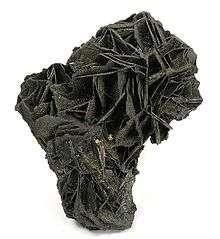Supergene (geology)
In ore deposit geology, supergene processes or enrichment are those that occur relatively near the surface as opposed to deep hypogene processes. Supergene processes include the predominance of meteoric water circulation with concomitant oxidation and chemical weathering. The descending meteoric waters oxidize the primary (hypogene) sulfide ore minerals and redistribute the metallic ore elements. Supergene enrichment occurs at the base of the oxidized portion of an ore deposit. Metals that have been leached from the oxidized ore are carried downward by percolating groundwater, and react with hypogene sulfides at the supergene-hypogene boundary. The reaction produces secondary sulfides with metal contents higher than those of the primary ore. This is particularly noted in copper ore deposits where the copper sulfide minerals chalcocite Cu2S, covellite CuS, digenite Cu1.8S, and djurleite Cu31S16 are deposited by the descending surface waters.[1]
All such processes take place at essentially atmospheric conditions, 25 °C and atmospheric pressure.[2]
Zones



Different zones can be identified at different depths. From the surface down they are gossan cap, leached zone, oxidized zone, water table, enriched zone (supergene enriched zone) and primary zone (hypogene zone).[3]
Gossan cap
Pyrite FeS2 is generally abundant, and near the surface it oxidises to insoluble compounds such as goethite FeO(OH) and limonite,[2] forming a porous covering to the oxidized zone known as gossan or iron hat.[4] Prospectors take gossan as an indication that there might be reserves of ore underneath.
Leached zone
The groundwater contains dissolved oxygen and carbon dioxide, and as it travels downwards it leaches out the minerals in the rocks to form sulfuric acid, and other solutions that continue moving downwards.[5]
Oxidized zone
Above the water table the environment is oxidizing, and below it is reducing.[6] Solutions travelling downward from the leached zone react with other primary minerals in the oxidised zone to form secondary minerals[5] such as sulfates and carbonates, and limonite, which is a characteristic product in all oxidised zones.[3]
In the formation of secondary carbonates, primary sulfide minerals generally are first converted to sulfates, which in turn react with primary carbonates such as calcite CaCO3, dolomite CaMg(CO3)2 or aragonite (also CaCO3, polymorphic with calcite) to produce secondary carbonates.[4] Soluble salts continue on down, but insoluble salts are left behind in the oxidised zone where they form. An example is the lead mineral anglesite PbSO4. Copper may be precipitated as malachite Cu2(CO3)(OH)2 or azurite Cu3(CO3)2(OH)2.[3] Malachite, azurite, cuprite Cu2O, pyromorphite Pb5(PO4)3Cl and smithsonite ZnCO3 are stable in oxidising conditions[6] and they are characteristic of the oxidation zone.[3]
Water table
At the water table the environment changes from an oxidizing environment to a reducing one.[6]
Enriched zone
Copper ions that move down into this reducing environment form a zone of supergene sulfide enrichment.[3] Covellite CuS, chalcocite Cu2S and native copper Cu are stable in these conditions[6] and they are characteristic of the enriched zone.[3]
The net effect of these supergene processes is to move metal ions from the leached zone to the enriched zone, increasing the concentration there to levels higher than in the unmodified primary zone, possibly producing a deposit worth mining.
Primary zone
The primary zone contains unaltered primary minerals.[5]
Mineral alterations
Chalcopyrite CuFeS2 (primary) readily alters to the secondary minerals bornite Cu5FeS4, covellite CuS and brochantite Cu4SO4(OH)6.[5]
Galena PbS (primary) alters to secondary anglesite PbSO4 and cerussite PbCO3.[2][5]
Sphalerite ZnS (primary) alters to secondary hemimorphite Zn4Si2O7(OH)2.H2O, smithsonite ZnCO3 and manganese-bearing willemite Zn2SiO4.[2][5]
Pyrite FeS2 (primary) alters to secondary melanterite FeSO4.7H2O.[5]
If the original deposits contain arsenic and phosphorus bearing minerals secondary arsenates and phosphates will be formed.[5]
See also
References
- ↑ Guilbert, John M. and Charles F. Park, Jr (1986) The Geology of Ore Deposits, W. H. Freeman, ISBN 0-7167-1456-6
- 1 2 3 4 Manual of Mineralogy (1993) Klein and Hurlbut. Wiley
- 1 2 3 4 5 6 Understanding Mineral Deposits (2000). Kula C Misra. Kluwer Academic Publishers
- 1 2 The Encyclopedia of Gemstones and Minerals (1991). Martin Holden. Publisher: Facts on File
- 1 2 3 4 5 6 7 8 Field Guide to North American Rocks and Minerals (1992) The Audubon Society. Alfred A Knopf
- 1 2 3 4 John Rakovan (2003) Rocks & Minerals 78:419